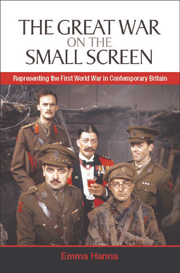Book contents
- Frontmatter
- Contents
- Acknowledgements
- List of abbreviations
- List of illustrations
- Introduction
- 1 An Unhealed Wound: Britain and the First World War
- 2 A Monumental Monument: The Great War (BBC, 1964)
- 3 Survivors: Veterans and the Nature of Personal Testimony
- 4 Heroes and Villains
- 5 Drama, Comedy and Drama Documentary
- 6 Over the Top: Reality Experiential Television
- 7 The Fear of Forgetting
- Filmography
- Bibliography
- Index
1 - An Unhealed Wound: Britain and the First World War
Published online by Cambridge University Press: 05 August 2013
- Frontmatter
- Contents
- Acknowledgements
- List of abbreviations
- List of illustrations
- Introduction
- 1 An Unhealed Wound: Britain and the First World War
- 2 A Monumental Monument: The Great War (BBC, 1964)
- 3 Survivors: Veterans and the Nature of Personal Testimony
- 4 Heroes and Villains
- 5 Drama, Comedy and Drama Documentary
- 6 Over the Top: Reality Experiential Television
- 7 The Fear of Forgetting
- Filmography
- Bibliography
- Index
Summary
Britain and the First World War
In Great Britain the First World War has been commemorated more than any other conflict. Throughout the 1920s small shrines erected on many street corners were replaced by thousands of memorials in stone and bronze. The majority of cities, towns and villages experienced loss and this had a profound effect on the ways in which the war has been remembered. The public organisation of private grief via the erection of thousands of war memorials meant that death became closely associated with Britain's public memory of the First World War. Britain needed to remember.
As war memorials enshrined the experience of loss, the accepted language of remembrance was established through ritual acts and ceremonies. A wooden Cenotaph at the centre of Whitehall was erected in 1919: an empty tomb in remembrance of all those who died in the First World War. The temporary structure was replaced by the present stone version in 1920. The Service of Remembrance at the Cenotaph – including the two minute silence – has been broadcast on BBC radio every year from 1923, and it has been televised since 1937 with a six-year hiatus during the Second World War. In November 1921, the British Legion established the sale of red poppies every 11 November, an annual act of individual remembrance which was cemented in ceremonial ritual by the laying of poppy wreaths at memorials. Since the 1920s, the British Legion has also held an annual Festival of Remembrance at the Royal Albert Hall.
- Type
- Chapter
- Information
- The Great War on the Small ScreenRepresenting the First World War in Contemporary Britain, pp. 7 - 31Publisher: Edinburgh University PressPrint publication year: 2009



